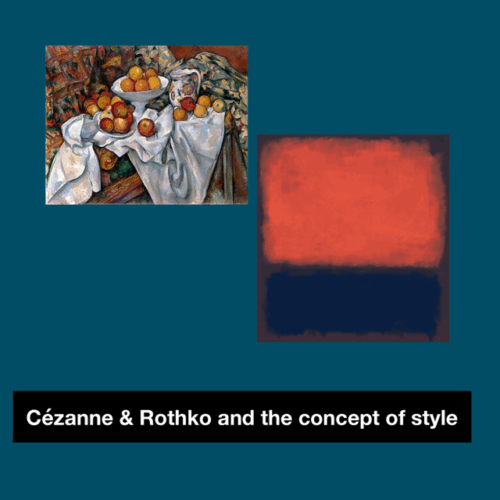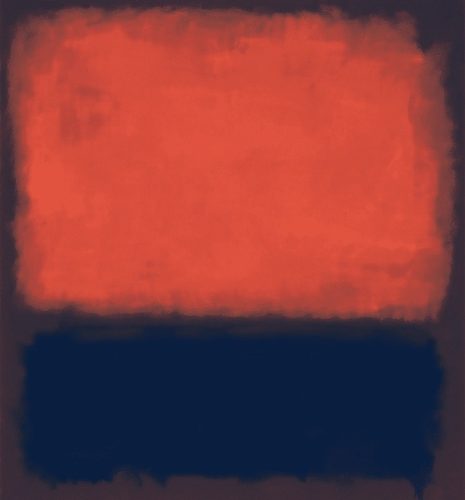
Reflections :
On the concept of style for the practice of art history
The usefulness of style analysis, is in that it offers, a framework for classifying, comparing, and interpreting, focused on ‘how’ an artwork is made, asserts British art historian Jás Elsner. Formal analysis distinguishes individual creativity, and also reflects the broader connections and influences, made across time, such as linking Cézanne and Rothko, as part of a larger dialogue about form and cultural resonance. Clearly, regarding their respective styles, each artist comes from a different period, and is associated with a different artistic movement: Post-Impressionism for the former, and Abstract Expressionism for the latter. Nevertheless, both artists share fundamental artistic and formal concerns, albeit in distinct ways.
They similarly emphasised materiality and colour, form and texture, over and above, subject matter. A still life by Cézanne, depicts carefully arranged objects, fruit, a jug, folded cloth, with a deliberate focus on geometric simplification. He creates tension between naturalism and abstraction, which invites reflection. Discrepancies are expressed through contrasts, between ill-formed objects and harmonious colours, between solid organic objects and delicate vessels, between proximity and remoteness. More broadly speaking, Cézanne’s work, though rooted in the depiction of ‘recognisable’ objects, and landscapes, bridged the gap between representation and the more conceptual experimentations of artists, such as Rothko. Likewise, both artists sought to transcend mere representation, by disregarding traditional perspective. Eliminating perspective or ‘any other conventional indicators of measure’, permitted Rothko to produce floating ‘organisms’ that appear to be constantly shifting. He pushed further than Cézanne, the process of ‘purification’, retaining simply the essence of emotions. Making colour, and colour interactions, the vital elements of his work, and the specificity of the Rothko style.
While stylistic analysis provides valuable tools for examining the formal qualities of an artwork, its shortcomings can lead, nevertheless, to tidy classifications, such as with the category, ’Modernist’. Whereby ‘style’ becomes associated with an imposed construction, marginalising, or excluding, other existing movements, or potential readings of a work of art. Clearly, the relation between image and meaning is crucial. Therefore, by separating form from the social, cultural and historical contexts, the intentions of an artist or the reception of an artwork, can only deliver a reductive understanding. Indeed, an artwork is shaped by the artist’s environment. Reducing style to formal elements alone, ignores the emotional, conceptual or narrative dimensions which are vital to interpretation. Biographical knowledge encompassing, writings, correspondence, or interviews of an artist, are an additional source, to better understanding an artwork, an artist, or a movement.
Bonnie Clearwater, in The Rothko Book, relies on the artist’s written exchanges with fellow artists, to reveal his interest in the emotional and spiritual resonance of colour and shape. A correspondence which similarly revealed, Rothko’s disapproval of ‘Greenberg’s purist point of view’, and the ‘notion that a painting was a self-contained object with no outside reference’, which was ‘alien’ to him’. Many insights that are not acknowledged in purist formalism include, Cézanne’s friendships and influences, Rothko’s spiritual transcendence, Cézanne’s deep ties to the landscape of Provence, Rothko’s background as a Jewish immigrant and his engagement with existential themes. Art does not exist in a vacuum, it is deeply embedded in the social, cultural and political contexts of its time. Post-structuralist thinkers including Michel Foucault, challenged the over emphasis on ‘form’, advocating instead for a fluidity of meaning and a broader interpretative framework which includes the production and reception of works of art.
The concept of style has been defined and challenged in many ways, and will continue to evolve, as it navigates the complexities of modernity. From a tool, to a norm, to a mark of identification, as art historian Sauerländer notes, stylistic analysis continues nevertheless to serve, as an essential method of interpretation in art history. While it provides valuable insights into the formal properties of Cézanne’s still-life and Rothko’s multiform, its limitations become evident, when the artworks are examined without context. A narrow focus on form significantly limits our understanding of an artwork’s broader meaning. It is therefore, necessary to adopt a comprehensive approach, ranging from the monograph, to iconography, and social art history or psychoanalytical biography for example, to fully appreciate the works of Cézanne and Rothko. To enrich our understanding, by placing their art within the complex contexts of their times, as well as in relation to the present.
While style offers a valuable entry point, the full significance of a work of art also emerges when investigating the dialogue between artist and audience. This assessment has attempted to show how Cézanne and Rothko aspired for their viewers : to see, to feel and to think, when faced with their works and their belief, that the viewer ‘actively completes’ the work of art. Cézanne and Rothko, each in their own way, ushered their viewers, from a status of ‘viewing’ to one of ‘experiencing’ their art.
Elsner, J. (2003) ‘Style’, in R.S. Nelson and R. Shiff (eds.) Critical Terms for Art History. (2nd edn). The University of Chicago Press.
Sauerländer, W. (1983), From Stilus to Style : Reflections on the fate of a notion.
Clearwater, B. (2006) The Rothko Book (ed.) Clearwater B. Tate Publishing London

Mark Rothko, No. 14, 1960, oil on canvas, 290.83 x 268.29 cm, The San Francisco Museum of Modern Art

Paul Cézanne, Apples and Oranges, 1899, oil on canvas, 74 x 93 cm, Musée d’Orsay Paris
https://tickmybox.ch/enigmatic-jackson/
https://tickmybox.ch/the-elgin-marbles/
Views: 29
